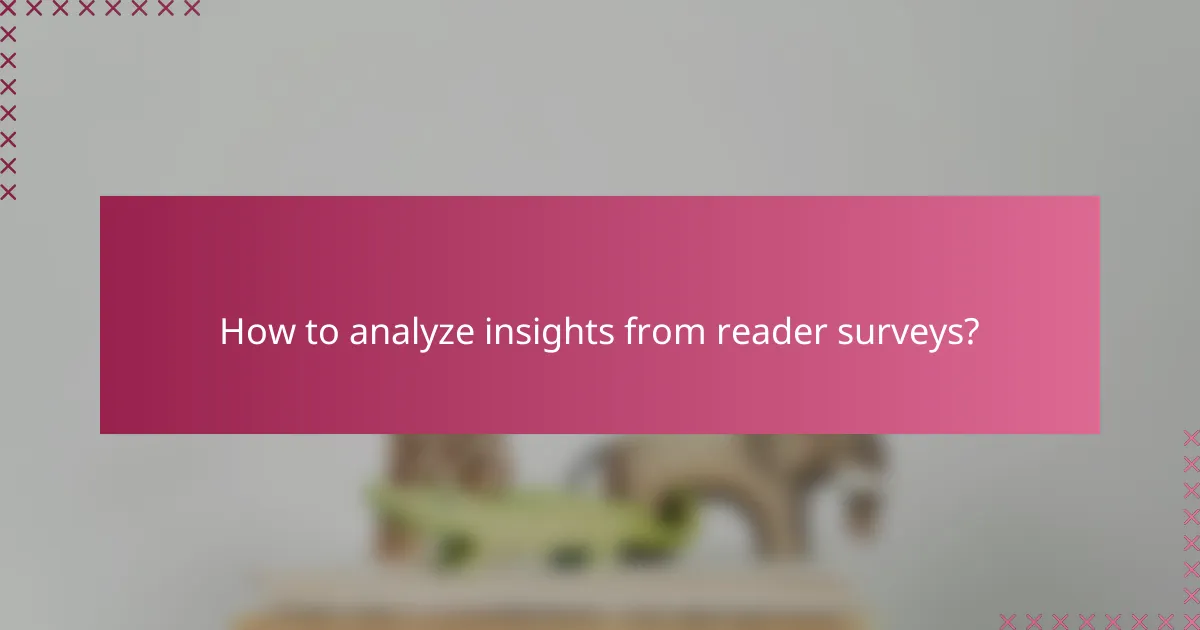Reader surveys are essential tools for gathering valuable insights that can enhance content strategies. By designing clear and targeted questions, distributing surveys effectively, and analyzing the collected data, organizations can better understand their audience’s preferences and needs. This process not only informs future content but also fosters a more engaged readership.

How to design effective reader surveys?
Designing effective reader surveys involves creating clear, targeted questions that yield actionable insights. Focus on your goals, question types, layout, branding, and testing to ensure a successful survey experience.
Define clear objectives
Start by identifying the specific information you want to gather from your readers. Clear objectives guide the survey’s design and help keep questions focused and relevant. For instance, if you want feedback on a recent article, your objective might be to assess reader engagement and satisfaction.
Consider using the SMART criteria—Specific, Measurable, Achievable, Relevant, Time-bound—to refine your objectives. This approach ensures that your survey will provide valuable insights that align with your goals.
Select appropriate question types
Choose question types that best suit your objectives and the information you seek. Common types include multiple-choice, rating scales, open-ended, and yes/no questions. Each type serves a different purpose; for example, rating scales can gauge satisfaction levels, while open-ended questions allow for detailed feedback.
Mixing question types can enhance engagement and provide a richer dataset. However, avoid overly complex questions that may confuse respondents or lead to incomplete answers.
Ensure user-friendly layout
A user-friendly layout is crucial for encouraging participation. Keep the survey visually appealing and easy to navigate, using clear headings and logical flow. Limit the number of questions to maintain reader interest—aim for a completion time of under 5 minutes.
Utilize mobile-responsive design to accommodate users on various devices. A straightforward layout with progress indicators can also enhance the user experience, making respondents feel more comfortable completing the survey.
Incorporate branding elements
Integrating branding elements into your survey helps reinforce your identity and builds trust with respondents. Use your logo, brand colors, and consistent fonts to create a cohesive look. This familiarity can encourage readers to participate and provide honest feedback.
However, avoid overwhelming the survey with branding; the focus should remain on the questions. Subtle branding elements can enhance recognition without detracting from the survey’s purpose.
Test survey before launch
Before launching your survey, conduct a test run with a small group to identify any issues. This pre-launch testing can reveal confusing questions, technical glitches, or layout problems that may hinder completion. Aim for feedback on clarity and ease of use.
Make necessary adjustments based on the feedback received. Testing not only improves the survey quality but also increases the likelihood of obtaining meaningful responses from your broader audience.

What are the best distribution methods for reader surveys?
The best distribution methods for reader surveys include email campaigns, social media platforms, website pop-ups, and partnerships with influencers. Each method has unique advantages and considerations that can significantly impact response rates and the quality of insights gathered.
Email campaigns
Email campaigns are one of the most effective ways to distribute reader surveys. They allow for targeted outreach to specific segments of your audience, increasing the likelihood of engagement. Personalizing emails can further enhance response rates.
To maximize effectiveness, consider sending surveys at optimal times, such as mid-week mornings. Keep the survey concise, ideally under 10 questions, to respect your readers’ time and encourage completion.
Social media platforms
Social media platforms provide a broad reach for distributing reader surveys. Utilizing channels like Facebook, Twitter, and Instagram allows you to engage with diverse demographics and drive traffic to your survey link.
When using social media, create eye-catching posts and consider using paid promotions to enhance visibility. Engaging visuals or short videos can capture attention and encourage shares, further expanding your reach.
Website pop-ups
Website pop-ups can effectively capture the attention of visitors while they browse your site. These prompts can be timed to appear after a user has spent a certain amount of time on a page or when they show intent to exit.
Ensure that pop-ups are not intrusive; they should be easy to close and mobile-friendly. Offering incentives, such as discounts or exclusive content, can increase participation rates significantly.
Partnerships with influencers
Partnering with influencers can amplify your survey distribution by leveraging their established audiences. Influencers can authentically promote your survey, increasing trust and encouraging their followers to participate.
Choose influencers whose audience aligns with your target demographic for the best results. Collaborate on messaging and ensure that the survey is relevant to their followers to enhance engagement and response rates.

How to analyze insights from reader surveys?
Analyzing insights from reader surveys involves systematically reviewing the collected data to extract meaningful conclusions. This process helps identify areas for improvement and informs future content strategies.
Use data visualization tools
Data visualization tools, such as charts and graphs, can simplify complex survey results, making them easier to interpret. Tools like Tableau or Google Data Studio allow you to create visual representations that highlight key findings and trends.
When using these tools, focus on clarity and relevance. Choose visual formats that best represent the data, such as bar graphs for comparisons or pie charts for distribution. This approach enhances understanding and facilitates discussions with stakeholders.
Identify trends and patterns
Identifying trends and patterns in survey responses is crucial for understanding reader preferences and behaviors. Look for recurring themes in open-ended responses and analyze quantitative data for shifts over time.
For instance, if a significant percentage of readers express interest in specific topics, consider prioritizing those in future content. Regularly reviewing these trends can help adapt your strategy to meet evolving audience needs.
Segment responses by demographics
Segmenting survey responses by demographics, such as age, gender, or location, allows for a more nuanced analysis of reader insights. This practice helps tailor content to specific audience segments, enhancing engagement and relevance.
For example, if younger readers show a preference for digital content while older demographics favor print, you can adjust your distribution strategy accordingly. This targeted approach can lead to improved reader satisfaction and loyalty.
Compare results with previous surveys
Comparing results with previous surveys provides context for current findings and helps track changes over time. This analysis can reveal whether implemented strategies have positively impacted reader satisfaction or engagement.
Establish a consistent methodology for conducting surveys to ensure comparability. Look for significant changes in key metrics, such as overall satisfaction ratings or content preferences, to inform future decisions and adjustments.

What are common pitfalls in reader survey design?
Common pitfalls in reader survey design include overly complex questions, neglecting mobile optimization, and ignoring participant privacy. These issues can lead to low response rates, biased results, and a lack of trust from participants.
Overly complex questions
Overly complex questions can confuse respondents and lead to inaccurate answers. Aim for clarity and simplicity by using straightforward language and avoiding jargon. For example, instead of asking, “How satisfied are you with the comprehensiveness of our content?”, consider, “How satisfied are you with our content?”
To enhance clarity, break down complex questions into smaller, manageable parts. This approach not only improves understanding but also encourages more thoughtful responses. A good rule of thumb is to keep questions to one main idea.
Neglecting mobile optimization
Neglecting mobile optimization can significantly reduce participation rates, as many users access surveys via smartphones. Ensure your survey is responsive and easy to navigate on smaller screens. Use larger buttons and concise text to facilitate quick responses.
Test your survey on multiple devices before distribution to identify any usability issues. A mobile-friendly design can increase completion rates by tens of percent, making it essential for reaching a broader audience.
Ignoring participant privacy
Ignoring participant privacy can deter individuals from completing your survey. Clearly communicate how their data will be used and ensure compliance with relevant regulations, such as GDPR in Europe or CCPA in California. This transparency builds trust and encourages honest feedback.
Implement measures to anonymize responses and secure data storage. Providing a privacy statement at the beginning of the survey can reassure participants and improve response rates. Always prioritize ethical considerations in your survey design.
